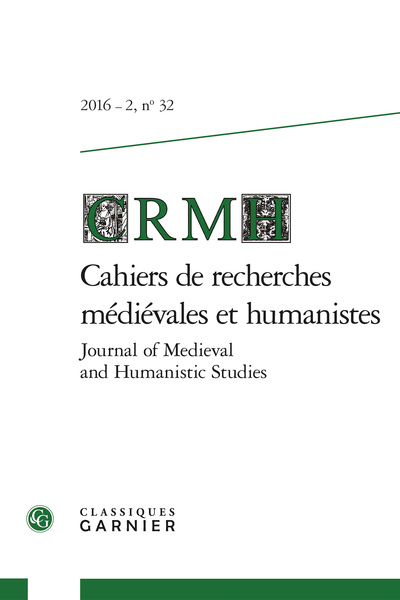
Introduction
- Type de publication : Article de revue
- Revue : Cahiers de recherches médiévales et humanistes / Journal of Medieval and Humanistic Studies
2016 – 2, n° 32. varia - Auteur : Blumenfeld-Kosinski (Renate)
- Pages : 83 à 85
- Revue : Cahiers de recherches médiévales et humanistes - Journal of Medieval and Humanistic Studies
- Thème CLIL : 4027 -- SCIENCES HUMAINES ET SOCIALES, LETTRES -- Lettres et Sciences du langage -- Lettres -- Etudes littéraires générales et thématiques
- EAN : 9782406067450
- ISBN : 978-2-406-06745-0
- ISSN : 2273-0893
- DOI : 10.15122/isbn.978-2-406-06745-0.p.0083
- Éditeur : Classiques Garnier
- Mise en ligne : 28/01/2017
- Périodicité : Semestrielle
- Langue : Anglais
Introduction
With her Livre du chemin de lonc estude of 1402-1403 Christine de Pizan created a work of political analysis and advice that participated in a number of popular genres: travel writing (both real and imaginary), allegory, mirrors of princes, and the kind of philosophical meditations and introspection popularized by Boethius’ Consolation of Philosophy. One of her principal inspirations was of course Dante who supplied the title for Christine’s complex work. The three essays in this dossier look at the relationship between these different genres in order to place the Chemin into some of the intellectual and artistic currents of its time and to show how Christine creates meaning for her contemporaries precisely through her text’s position at the crossroads of these different traditions.
Renate Blumenfeld-Kosinski analyzes the differences between Philippe de Mézières’ Songe du viel pelerin (1386-1389) and the Chemin from the perspective of how each author uses the idea of travel. Philippe, before his retreat to the Celestins in 1380 an inveterate traveler in real life, has his characters of the Old Pilgrim accompanied by Queen Truth and her cortège travel all over the world and uses each stop at a given geographical location as a locus for political analysis and advice. While large parts of the Songe are centered in Paris, it is nonetheless obvious that Philippe believed in the educational value of travel that would allow his team of travelers to gain the international perspective necessary for effective and well-grounded political lessons. By contrast, Christine de Pizan who was, unlike Philippe, merely an armchair traveler, uses only the stop in Constantinople as a springboard for political reflections, as Lori J. Walters shows. Thus, Blumenfeld-Kosinski argues, Christine plays tourist for most of her trip and does not shift into mirror-of-princes mode until she and her guide the Sibyl reach the heavens and encounter allegorical ladies who can debate the state of France and possible remedies for its dire situation.
84Thelma Fenster argues as well that Christine sees travel as inadequate for finding solutions to the problems of 1402 France. Fenster turns to Jean Mandeville’s Merveilles du monde of 1356-1357, one of the most popular fictional travel narratives of the Middle Ages. Mandeville did not actually travel, unlike the other immensely popular real traveler Marco Polo (d. 1324), but his exotic geography and marvels proved irresistible to most readers – though not to Christine. Fenster sees the Chemin as part of the reception history of Mandeville’s text and shows that Christine’s rejection of his narrative constitutes a deliberate signifier that would have been immediately recognizable to her aristocratic readers: by the evidence of their book ownership, they knew and greatly appreciated the Merveilles. Christine thus makes clear that she is attempting to redirect her contemporaries’ political discourse toward what she considers far more useful. So both Blumenfeld-Kosinski and Fenster highlight that Christine purposefully did not exploit earthly travel or travel narratives but rather insisted on a higher path leading from the world to the heavens and the insights that could be found only there.
Lori J. Walters brings together Christine’s earthly travels and the heavenly court of the wise allegorical ladies by focusing on two episodes in the Chemin that deal with Constantinople. In the first, Christine and the Sibyl arrive in that city and lament its state of disrepair although some signs of renewal are already visible. In the second, Constantinople is evoked by Lady Wisdom in the heavenly debate when she extols Chivalry in the shape of Jean de Châteaumorant (1352-1429), lieutenant to Marshal Boucicaut, who in 1399 was aiding the Byzantine Emperor Manuel II in securing the city post-Nicopolis. Walters speculates that Manuel II’s visit to Paris in 1402, trying to gain Charles VI’s support, could have been a trigger for Christine’s composition of the Chemin. But, Walters argues, Christine’s vision transcends the immediate circumstances of 1402. She has her eye on the Empire, or rather France as a successor to the Empire, even a new Holy Christian Empire. Does she not propose Charles VII in her Ditié de Jehanne d’Arc of 1429 as Emperor? Much happened between 1402 and 1429, almost all of it disastrous for France. Christine’s optimistic vision at the end of the Chemin of the French princes capable of solving their country’s problems by selecting the ideal universal monarch soon gave way to the despair of the Lamentation sur les maux de la guerre civile in 1410. The Chemin marks the beginning of 85Christine’s active engagement with contemporary politics, a path that would take her through some of the darkest periods of French history and would end with the glorious vision of Joan of Arc. Perhaps fortunately for her, Christine was spared from seeing the end of Joan’s own path.
Renate Blumenfeld-Kosinski
University of Pittsburgh